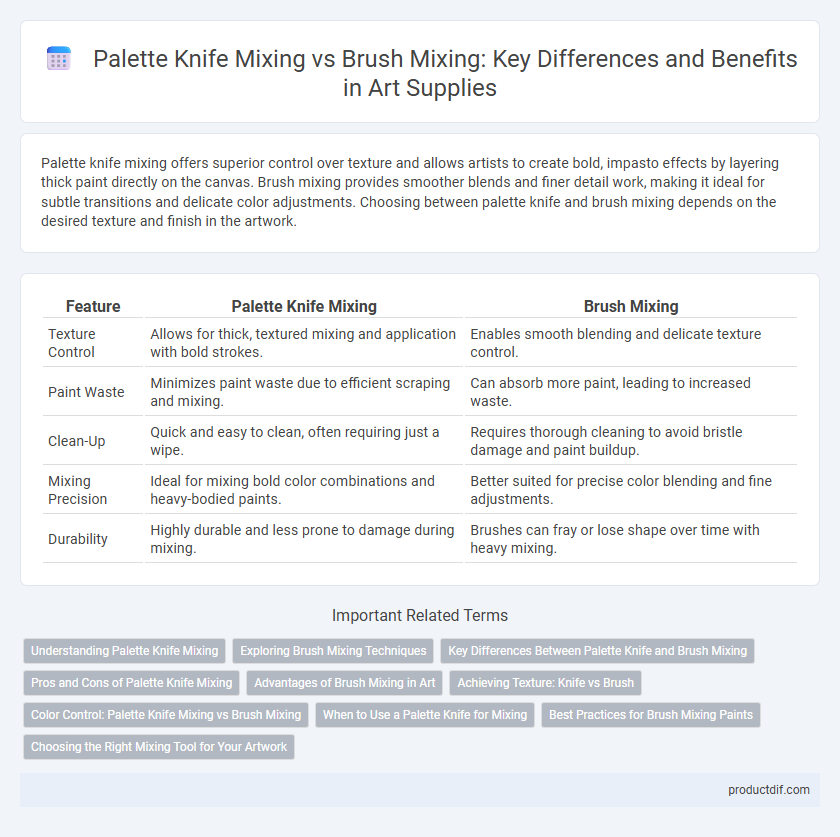Palette knife mixing offers superior control over texture and allows artists to create bold, impasto effects by layering thick paint directly on the canvas. Brush mixing provides smoother blends and finer detail work, making it ideal for subtle transitions and delicate color adjustments. Choosing between palette knife and brush mixing depends on the desired texture and finish in the artwork.
Table of Comparison
| Feature | Palette Knife Mixing | Brush Mixing |
|---|---|---|
| Texture Control | Allows for thick, textured mixing and application with bold strokes. | Enables smooth blending and delicate texture control. |
| Paint Waste | Minimizes paint waste due to efficient scraping and mixing. | Can absorb more paint, leading to increased waste. |
| Clean-Up | Quick and easy to clean, often requiring just a wipe. | Requires thorough cleaning to avoid bristle damage and paint buildup. |
| Mixing Precision | Ideal for mixing bold color combinations and heavy-bodied paints. | Better suited for precise color blending and fine adjustments. |
| Durability | Highly durable and less prone to damage during mixing. | Brushes can fray or lose shape over time with heavy mixing. |
Understanding Palette Knife Mixing
Palette knife mixing offers precise control over color blending by allowing artists to combine pigments directly on the palette, creating rich textures and vibrant hues unattainable with brushes. Unlike brush mixing, which can introduce unwanted brushstrokes and dilute pigment intensity, palette knives maintain pigment purity and facilitate thick, impasto techniques. Mastery of palette knife mixing enhances the ability to manipulate paint consistency, enabling dynamic layering and dramatic effects in both oil and acrylic painting.
Exploring Brush Mixing Techniques
Brush mixing techniques in art supply offer precise control over color blending, enabling artists to achieve smooth gradients and subtle tonal variations on canvas. Unlike palette knife mixing, which creates texture and impasto effects, brush mixing allows for seamless integration of hues directly on the painting surface. Mastering brush strokes, pressure, and layering enhances color depth, making brush mixing essential for detailed and refined artwork.
Key Differences Between Palette Knife and Brush Mixing
Palette knife mixing offers a textured, impasto effect by applying thick layers of paint, while brush mixing provides smoother, blended transitions with more control over fine details. Palette knives prevent colors from becoming muddy by enabling distinct separation, whereas brushes tend to mix colors more thoroughly on the canvas. The choice between palette knife and brush mixing depends on the desired finish, with palette knives suited for bold, expressive strokes and brushes for delicate, intricate work.
Pros and Cons of Palette Knife Mixing
Palette knife mixing offers superior texture control and allows for thick, impasto effects that are difficult to achieve with brushes, enhancing the physical dimension of paintings. It minimizes color contamination by preventing brush fibers from mixing hues, leading to purer blends and more vibrant colors. However, palette knives can limit fine detail work and require more practice to master precise control compared to the versatility of brush mixing.
Advantages of Brush Mixing in Art
Brush mixing in art offers superior control over color blending and consistency, enabling artists to achieve more precise gradients and subtle hues. The flexibility and varying bristle shapes of brushes allow for intricate textural effects and smoother application on canvas compared to palette knives. Moreover, brushes facilitate easier layering and glazing techniques, enhancing the depth and richness of the artwork.
Achieving Texture: Knife vs Brush
Palette knife mixing creates bold, textured layers with thick applications and sharp edges, allowing artists to achieve dynamic, sculptural effects on canvas. Brush mixing offers smoother, subtler texture variations through controlled strokes and blending, ideal for fine detail and gradual transitions. The choice between knife and brush directly impacts the tactile quality and dimensionality of the artwork's surface.
Color Control: Palette Knife Mixing vs Brush Mixing
Palette knife mixing offers precise color control by allowing artists to blend pigments directly on the palette, creating sharp, textured strokes with minimal color contamination. Brush mixing can result in softer transitions but risks muddying colors due to bristle absorption and uneven pigment distribution. Choosing palette knives enhances vibrancy and clarity in color application, crucial for bold, dynamic artworks.
When to Use a Palette Knife for Mixing
Use a palette knife for mixing when creating thick, textured paints or blending heavy-bodied acrylics and oils to achieve bold, dynamic effects. Ideal for combining colors without diluting pigments, palette knives preserve paint consistency and prevent brush damage. Opt for palette knife mixing when working on impasto techniques or when seeking sharp, clean color separations in your artwork.
Best Practices for Brush Mixing Paints
Brush mixing paints requires selecting high-quality, synthetic or natural bristle brushes to ensure smooth color blending and even application. Using circular or back-and-forth strokes facilitates thorough mixing on the palette or canvas, minimizing streaks and maintaining pigment vibrancy. Cleaning brushes promptly between color shifts prevents contamination and preserves the purity of mixed hues for professional-quality artwork.
Choosing the Right Mixing Tool for Your Artwork
Palette knife mixing offers textured, bold strokes ideal for impasto techniques, while brush mixing provides smoother blends perfect for detailed transitions in oil and acrylic paintings. Artists should consider the desired texture, paint consistency, and painting style when selecting between palette knives and brushes. Using palette knives allows for more control over thick, layered applications, whereas brushes enable precise control for fine color gradients and subtle mixing.
Palette Knife Mixing vs Brush Mixing Infographic

 productdif.com
productdif.com